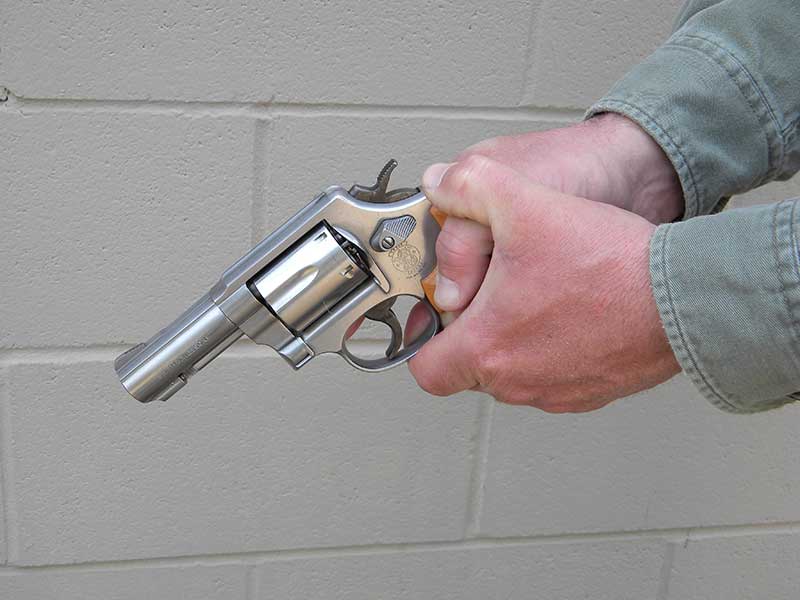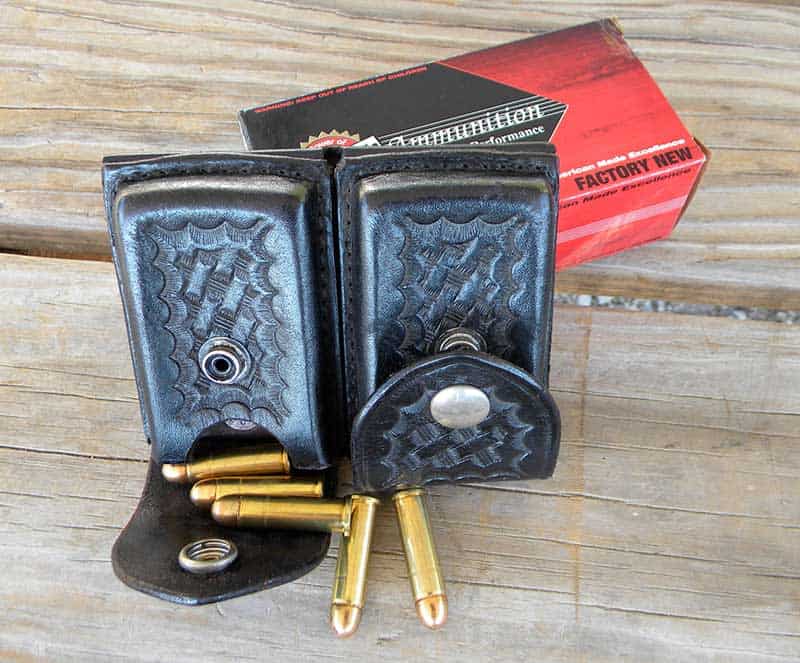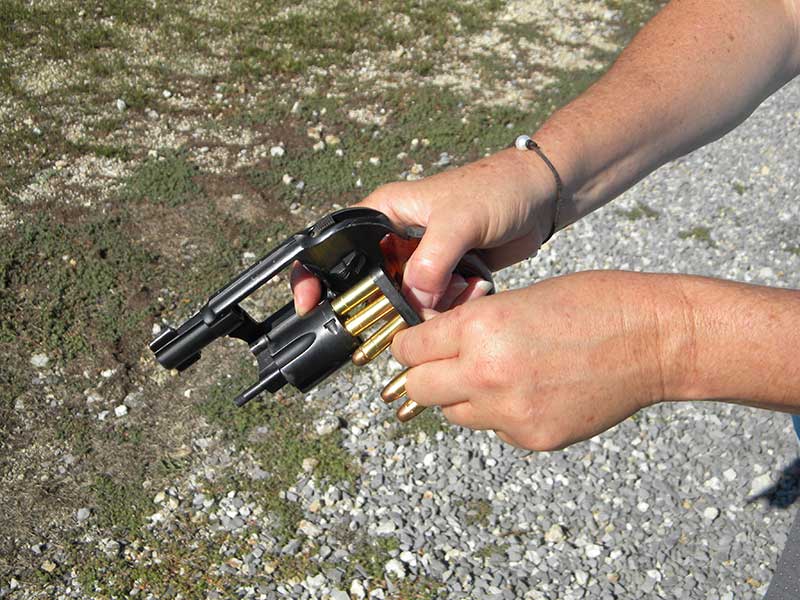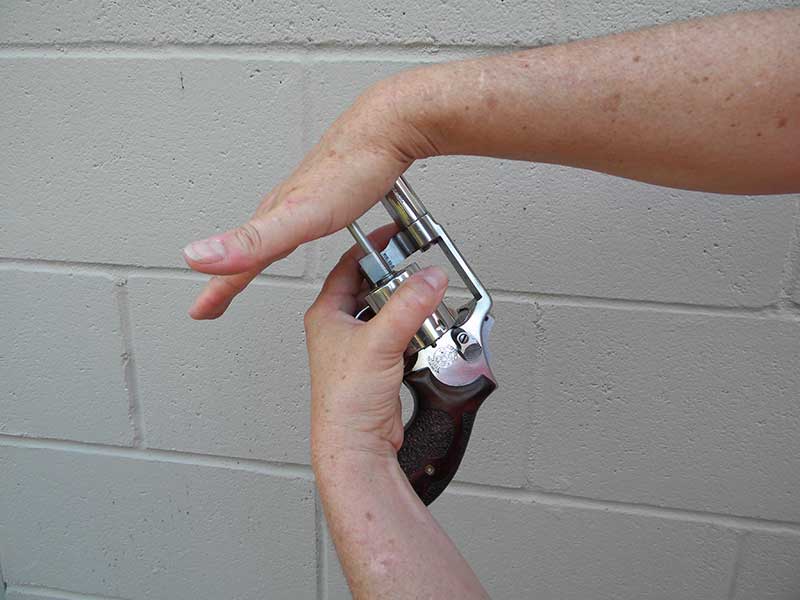Revolver 101
In This Age Of Autos, Many Shooters Don’t Know How To Run A Wheelgun Properly. And It’s Too Good A Tool To Ignore.
I’ve been doing an informal survey in classes lately and it’s sort of surprising the number of students who have never fired a revolver. Yes, it’s a design that has been around for many years, but these old wheelguns actually still have a lot to offer. Like any other firearm it’s all about knowing how to use them. Even if you’re not thinking about owning one, it’s a good idea to at least know the basic fundamentals on how to handle one.
The “traditional” grip is with the thumbs crossed down low (above). Most of the control with the revolver, when using a two-hand grip, comes from the support hand. The alternative grip (below), especially with a small revolver and/or large hands, is to position the support thumb higher on the strong thumb.
Get the Right Grip
One of the first things about revolvers is the way you grip them. The grip for the revolver is different from how you grip a semi-auto. You want the strong hand high on the backstrap, just like with a semi-auto. The difference is in how you position your thumbs. With the semi-auto you stack your thumbs one over the other. But doing this can lead to trouble with the revolver.
You don’t want the support thumb rubbing or pressing against the cylinder, which can prevent the cylinder from rotating and locking in properly, making the trigger difficult to press. Plus, depending on your hand and gun size, the support thumb can get in the way of your trigger finger, forcing you to change your grip while pressing the trigger or having to reposition the trigger finger as you press. Either way the gun will probably shift in your hands as you’re trying to fire it.
A big danger is the gas released and vented to the sides of the cylinder. If your support thumb is sticking way out in front of the cylinder, it catches this blast which can cause severe damage. With large caliber revolvers, this pressure can actually blow the tip of your thumb off. (If you want to see the gory evidence, search the ’net for “revolver thumb injury.”) So crossed thumbs it is.
With revolvers there are a couple of different ways to position the thumb on your support hand. The most common method is to cross your support thumb over the top of the strong hand thumb. There are a couple of different techniques, and where you cross your support thumb depends on hand and pistol size. The support thumb can cross low over the top of your strong thumb, right between thumbnail and the knuckle. With smaller hands and a small-frame gun this method works well. With larger hands and/or a smaller gun your support thumb can be positioned higher, crossing over the strong thumb behind the knuckle, closer to where your thumb meets your hand.
With revolvers about 70 percent or so of your ability to control and recover from recoil is achieved with the support hand. Again this is different from semi-auto pistols, where the strong hand is the one really controlling the pistol and the support hand basically assists in recoil recovery.
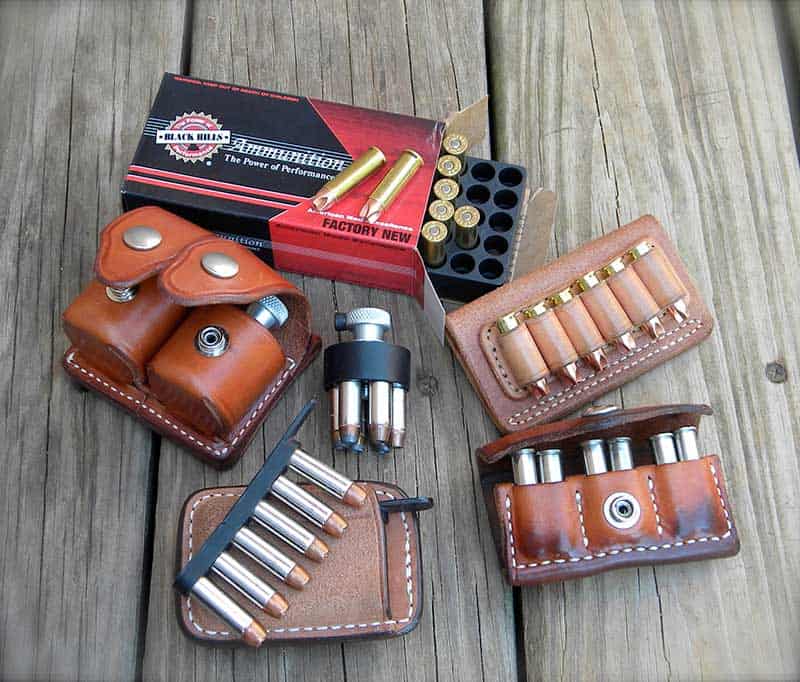
There are a lot of ways to carry spare revolver ammo — speed strips, speed loaders, or pouches that
carry rounds and slides with loops to separate the rounds. How and where you carry it determines how
you manipulate the revolver. A lot of practice and experimenting is required to find what’s best for you.
Carrying Ammo
With a semi-auto, carrying spare ammo is easy. You carry it in magazines. For revolvers there are several options — each has advantages and disadvantages so you’ll need to experiment to discover what works best for you. How you carry ammo can dictate the techniques you use to load the revolver.
In the old days you carried spare ammo in “dump” pouches. They work like this: Open the pouch and it dumps ammo into your hand. Feeding rounds into the cylinder while trying to hold onto a handful of loose ammo is hard under good conditions. Under stress it’s extremely difficult.
Today there are belt pouches to hold the rounds in place, such as El Paso Saddlery Company’s 2×3 Pick Box, a pouch holding six rounds segregated into three compartments. You open the pouch and then you pull out one or two rounds at a time to load into the cylinder. I really like this pouch. It protects the ammo from the external elements, plus most people won’t know what it is.
“Loops” or “slides” go on your belt and have loops to hold individual rounds. They work well, but don’t provide the rounds with any protection like the pouch mentioned above. They do have a slim, easily concealable profile, but if they’re uncovered, people will immediately be able to see you’ve got ammo on your belt.
Speed strips are flexible rubber strips that hold rounds. Once the rounds have been inserted into the cylinder, usually two at a time, you bend the strip, which releases the rounds. Strips are an excellent way to carry spare ammo, but you don’t want to just stick it into a pocket. A pouch, whether it’s on a belt or in a pocket, keeps rounds from collecting dirt and grime which can hinder loading or lock up the cylinder.
Speedloaders are another option. They must be matched up specifically for the type revolver you are using and hold five, six or more rounds. This is the quickest way to feed the revolver because you’re loading all the rounds at once. But this can be a disadvantage because you have to load all of them. If you fire two shots and just want to replace those two empties — a “tactical” reload — you need some loose rounds on hand — such as in a pouch or on a strip — or you have to dump the entire cylinder, including any live rounds. Loaders are also bulky, and while there are pouches to carry them, they can be difficult to conceal.
Some revolvers have cylinders cut to work with “moon” clips, which are like speed loaders except they are thin metal “stars” to hold the rounds. They are quick to load into the cylinder, but again you are limited to unloading everything in cylinder and reloading with the live rounds in the clip.
Your ammo can be carried on the strong side, support side, or more towards the front of the body or in pockets. Where you carry the ammo may dictate which hand does what, or the way you need to manipulate the handgun will determine where and how you carry spare ammunition.
Since there are many options to carry ammo you’ll have to work with the different methods to determine what will work best for you. Also, you may need one method of carrying ammo for one way you dress, and another method for other clothes you wear. Carrying ammo is just like holsters. You either dress to conceal how you carry, or how you are dressed dictates how you carry. Time and practice and experience will determine what works best.
While we’re on the subject of carrying ammo, make sure it’s a well-known brand hollowpoint or defensive round, one that has proven to perform well and shoots accurately in your pistol. One of the good things about revolvers such as the .357 Magnum is you can also shoot +P .38 Special, which has higher velocity than a standard-pressure .38 but less recoil than the magnum. And there are standard-pressure .38 loads that are still effective for defensive purposes.
Loading, Unloading
A semi-auto stays in your strong hand during loading/unloading manipulations. With the revolver you can either hold it in your strong hand, transfer it to your support hand, or use a combination of both techniques. Your gun and hand size, plus how you carry your spare ammo, will dictate which works best for you.
If you’re a right-hander, use the thumb of your right hand to press the cylinder release while your left hand moves underneath the revolver, positioning the two middle fingers on the right side of the cylinder where they can push the cylinder to the left. These two fingers go through the gate and the left thumb is on the left side of the cylinder, forming an “O” with the two middle fingers and thumb around the cylinder. Your left hand is now holding the cylinder and supporting the revolver, leaving your right hand free to handle ammo.
To load, point the muzzle down and feed the rounds in with your right hand. Your thumb and middle finger holding the cylinder can be used to rotate it if necessary to load — such as when using a speed strip. Once the cylinder is loaded, your right hand reacquires its grip, your left hand shifts back to the left side of the revolver and locks the cylinder in using the heel of your hand. Be sure to use enough force to ensure the cylinder locks into place, otherwise you won’t be able to press the trigger.
For unloading, use the same technique to open the cylinder. This time point the muzzle up instead of down. With the revolver in your left hand, use the heel of your right hand to forcefully smack the ejector rod down to empty out the brass. In practice, always let live rounds or brass fall to the ground, just like you would during a fight. If you’re in the house and you don’t want to damage your expensive defense rounds, let them fall onto the bed or couch. Then it’s muzzle down to reload the cylinder.
Or, you can do all this with your right hand holding the revolver. To open up the cylinder you bring your trigger finger up to the cylinder and your right thumb over the grip to the right side of the revolver. Keep your right thumb out of the way so it’s not blocking the cylinder. Use your left thumb to press the cylinder release latch and the trigger finger of your right hand to push the cylinder to the left, following it through the gate where it can apply pressure to the cylinder to keep it from spinning freely or flopping back into a closed position. Your left hand loads, rotating the cylinder if necessary, and then closes it and locks it in place.
Unloading follows the same procedure. Once the cylinder is open the muzzle goes up, and the heel of the left hand punches the ejector. I use the barrel as a guide, positioning the web between my thumb and first finger on the barrel and then sliding my hand down to hit the ejector rod. After the cylinder is empty you point the muzzle down to load.
Ready On The Left!
A left hand shooter will use the same techniques, but with minor variations. For example, to open up the cylinder the right thumb comes around the grip to press the latch while the left hand opens the cylinder, using the same “O” shape as described above, with the left hand holding the cylinder while the right hand loads. Another option is to use the left thumb to work the latch while the right hand thumb pushes the cylinder to the left with a couple of fingers of the right hand — usually the middle two — on the other side of the cylinder, again forming an “O” shape to hold the cylinder. With this technique the left hand is handling the ammo.
Another option is the “tactical” reload. You’ve fired two rounds. The threat is down or gone, you’ve scanned and moved into position behind cover. When it’s as safe as you can assess, you want to change out those two empties. Right-hand shooters can keep the revolver in the right hand, using the left hand to press the ejector rod back slightly, trapping the two empty cases. Release the ejector, pull out the empties and then reload two live rounds. You can transition the revolver to the left hand, using the right hand to remove and replace the rounds. Lefties will need to transfer the revolver over to the right hand, working the tactical reload as a right-hander would.
How do you determine which technique works best for you? It takes experimenting and practice. For example, with a small-frame gun it’s pretty easy to keep it in your right hand. For someone with smaller hands, and/or a larger frame gun, it may be better to transfer the gun over to the support hand to provide a little more control during loading/unloading. Another factor is dexterity — how much one hand differs from the other. Your strong hand may be lot better at fine-motor skills than your support hand. If this is the case, transfer the gun to your support hand, freeing up your best hand to finesse feeding rounds into the cylinder.
Also keep this in mind: Time isn’t the only deciding factor. One technique may be a little quicker when you put the timer on it, but with this method you may sometimes end up fumbling or dropping rounds. Choose the technique that’s always the most effective instead of basing your decision entirely on what’s quickest. Don’t get me wrong. In a self-defense situation time is definitely a factor, but being efficient and getting predictable results from your actions is more important.
As always, the best way to develop your skills is with dry practice. Use dummy ammo to practice and to experiment with different techniques too. There’s no need to be wasting ammo on the range while you’re trying to figure out what works best. But once you’re getting everything working good you can head to the range for live fire practice.
Final Thoughts
There are a variety of ways to manipulate a revolver. Determining what works the best for you involves several factors. For example, one technique may work fine for someone with large hands and a larger frame gun, but a person with smaller hands and the same size pistol may need to use a different method.
Ultimately, learning how to manipulate a revolver requires a lot of experimentation and practice. First, you have to perform the skills using different techniques to decide what works best. Then, like all other skills, repetition is necessary to learn these skills, practicing until they can be performed at a subconscious level.
After getting to know your gear start experimenting again. Something that didn’t make sense initially, when you really didn’t know what you were doing, might work well now with your new, expanded education. Dry practice, as always, is the best way to achieve these results.
Revolvers have their advantages. For example when the fight is close and you have to shove it into your assailant’s ribs, revolvers don’t come out of battery like a semi-auto will. You don’t have to worry about “limp-wristing” — a revolver can be fired from compromised positions and still function. You can get rounds like the .357 Magnum in small packages. They might not be fun to shoot on the range, but they pack a punch. Even if you don’t anticipate carrying a revolver, it’s a good idea to know how to work one. There’s a lot of wheelguns out there; chances are good you may come across one and need to know how to use it.
Tiger McKee is director of Shootrite Firearms Academy, located in northern Alabama. He writes for several firearms/tactical publications and is featured on GunTalk’s DVD “Fighting With The 1911.” www.shootrite.org

Get More Carry Options content!
Sign up for the newsletter here:

